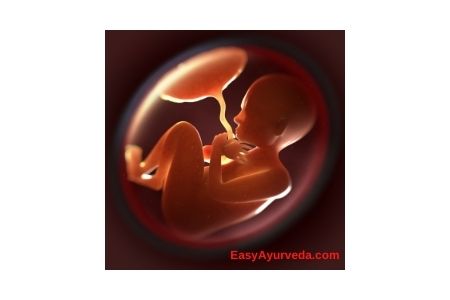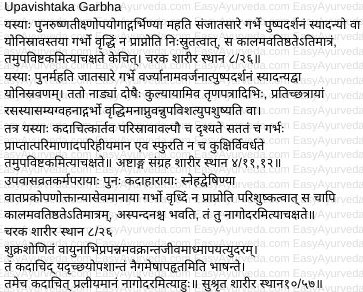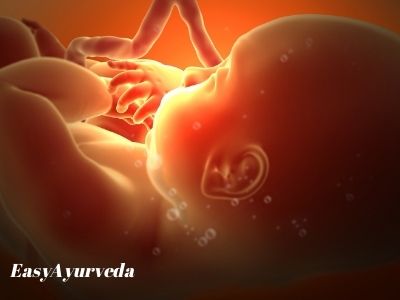Upavishtaka, Upashushka Garbha – Meaning, Symptoms, Treatment
By Dr Raghuram Y.S. MD (Ay) & Dr Manasa, B.A.M.S
Upavishtaka Garbha and Upashushka are fetal disorders. Both these conditions are explained together and so is their treatment.
Upavishtaka means to sit to stay in position for longer duration. This condition is called as Upavishtaka because the fetus stays / sits in the womb for longer time.
Upashushka means drying of the fetus in the womb. In both these conditions, the fetus doesn’t grow properly in the womb.
Read – Intrauterine Death Of Fetus In Ayurveda

Table of Contents
Upavishtaka Garbha
According to Master Charaka
(Ref – Charaka shareera sthana 8/26)
Causes – excessive consumption of hot and pungent foods by pregnant women.
Pathogenesis – Due to the above said etiological factors, bleeding from the vagina or other types of vaginal discharges occur after the fetus has developed to a certain extent and has attained sara i.e. after 4th month. Due to these discharges, the fetus does not grow properly and stays for a very long time. This condition is called as Upavishtaka.
According to Master Vagbhata
(Ref – Ashtanga sanghraha shareera sthana 4/11,12)
The author has mentioned the causes of Upavishtaka and Upasushka together. The pathogenesis is similar to that explained by Charaka.
If the woman consumes contraindicated articles after attainment of sara of the fetus, bleeding or other discharges may occur from the vagina. Vata gets aggravated due to this bleeding and withholds pitta and kapha and compresses the rasavaha nadi – channels carrying rasa tissue – of the fetus. Due to this obstruction, there will be improper flow of rasa. As a consequence, the fetus does not develop properly and becomes Upavishtaka or Upasushka. This happens in the same way as the paddy does not grow properly if the water does not reach the field due to obstruction to the passages of water with leaves and grass etc.
Specific etiology of Upavishtaka – When there is scanty but continuous bleeding from vagina, the fetus doesn’t decrease in size but continues the quivering. The uterus does not increase in size. Master Arunadatta specifies that this condition occurs when the fetus has become balawana – i.e. strong as in 5th or 6th months of pregnancy.
Read – Monthly Development Of Fetus – Ayurvedic perspective
Upasushka or Nagodara Garbha
Etiology and pathogenesis
1. Master Charaka’s opinion
(Ref – Charak shareera sthana 8/26)
The causes include –
- Too much fasting
- Eating stale food
- Not taking fats as required
- Use of vata vitiating things in excess
Read – Different Causes For Vata Dosha Imbalance, Increase
The fetus of a woman, who consumes the above said etiological factors, gets desiccated and does not grow. This fetus does remains in the uterus for a long time and does not quiver. This is known as Nagodara.
2. Master Sushruta’s opinion
(Sushrutha shareera sthana 10/59)
According to Master Sushruta, the sperm and ovum afflicted by vata after the descent of life element – jivatma – produces distension of abdomen. When this distension disappears, it is said that the fetus is taken away by Naigamesha.
Sometimes the fetus gets reabsorbed and when this happens it will be called as Nagodara.
Master Dalhana opines that this condition occurs before 3 months of pregnancy and the embryo remains in the uterus without decomposing. The size of the fetus decreases due to its dissolution in the channels.
3. Master Vagbhata’s opinion
Vagbhata I – The fetus decreases in size and quivers slightly when the pregnant woman gets excessive bleeding either daily or monthly. The size of the abdomen also decreases. This condition is called as Nagodara or Upasushka.
Vagbhata II – The vayu gets vitiated due to excessive grief, fasting and use of dry articles or due to excessive bleeding. This vitiated vayu produces emaciation of fetus, destroys it or desiccates it. This is called as Nagodara. This condition is marked by decrease of size of abdomen and delayed quivering of fetus.
Read – Untimely and Delayed Labor As Per Ayurveda (Garbha Sangha – Akala Prasava)
4. Master Bhela’s opinion
Due to the vitiation of the openings and orifices of the siras – channels of nutrition – the fetus does not get proper rasa – nutrition. This under developed fetus remains in the uterus for many years just like the fetus of an elephant. The fetus does not develop properly since the bleeding occurs from the vagina after the fetus has become jatasara i.e. after 4th month of pregnancy. It not only develops improperly but also gets desiccated and remains in the uterus.
Sanskrit Verses


Signs and Symptoms of Upavishtaka and Upashushka Garbha
1. Signs and symptoms of Vata predominance
The aggravated vayu attacks the pregnant woman. She passes liquids and frothy and fragmented stools with sound. She also suffers from –
- Retention of urine
- Back pain
- Sacral pain
- Pain in cardiac region
- Yawning
- Insomnia
- Severe coryza
- Dry cough
- Lassitude of body
- Itching in the ears
- Pricking pain in temples
- Sensation as if ants are crawling all over the body
- Cutting pain due to movement of vayu in the abdomen
- Feeling as if entering into the darkness
- Food gets digested with difficulty
- Gradual emaciation of the body
- Cracking, discoloration and roughness developing in the skin
2. Signs and symptoms of Pitta predominance
When pitta is vitiated –
- Stools are coppery or green in color
- Feeling as if mouth and throat are filled with smoke
- Vomiting of acidic taste
- Unconsciousness
- Burning sensation over abdomen and cardiac region
- Yellowness, redness or color resembling that of cow’s urine – of eyes, nails and urine
- Blackish discoloration of skin
- Weakness
- Continuous pain
3. Signs and symptoms of Kapha predominance
When kapha is vitiated –
- Sweet taste of mouth
- Nausea
- Vomiting containing mucus
- Dislike for food
- Whitishness of eyes and extremities
- Cough
- Dyspnea
When do upavishtaka and upashushka garbha get delivered?
Both these fetuses develop slowly by the fire of maternal diet. In the process, when these fetuses develop properly or when they get matured they get delivered, may be even after years. The hairs and teeth of the fetus also grow before the birth due to its prolonged stay in the uterus.
Read – Essential Elements For Conception – Garbha Sambhava Samagri
Treatment of Upavishtaka and Upasushka
1. General treatment of both conditions
a. Ghee prescribed to treat affliction of bhutas –
- Vacha Ghrta
- Guggulvadi Ghrta
- Mahapaishachika Ghrta
- Ghee, milk, meat soup and eggs / embryo prepared with jivaniya – herbs capable of enhancing longevity, brimhaniya – anabolic, madhura – sweet tasting and vatahara – herbs capable of suppressing vata
b. Milk or meat soup processed with the above said Jivaniya etc herbs should be prescribed.
c. The above said ghee should be used along with the diet also.
d. The woman, after having taken satiating foods, should do the below mentioned activities –
- Travel by vehicles repeatedly
- Frequent riding
- Agitating activities
- Yawning
- Use cleansing articles
- Offer donation (Indu)
e. The pregnant woman should be made cheerful repeatedly. This will help in the proper development of fetus.
Read – Mudha Garbha – Obstructed Labor, Ayurveda Perspective
2. Treatment of both conditions in accordance to the predominant dosha involved –
a. Treatment in vata predominance
- The woman should be given with enema of milk mixed with rock salt.
- Later bath should be given with cold water.
- He should then be given cooked shali rice for eating.
- After taking food, anuvasana vasti i.e. unctuous enema should be given. This enema should be prepared with herbs of Vidaryadi group of herbs mixed with ghee (ghee prepared with Vidaryadi group of herbs).
- Following this, she should be made to live in a place devoid of breeze.
b. Treatment in pitta predominance
Madhuka-Vidaryadi-Ksheera – Milk treated / processed with decoction or juice of licorice and Vidari – Pueraria tuberosa should be served.
Kukkuta-Masha-Yoga – Meat of 3 fat hens and 1 adhaka quantity of de-husked black gram should be pestled with milk and water. Its juice should be extracted. With this juice and ghee, meat of partridge, sparrow or any similar bird should be cooked. This should be served to the pregnant woman for eating. This formulation will increase the size of Upavishtaka garbha and helps in growth and development of Upashushka garbha.
Jivaniya Gana Siddha Yavagu – Gruel prepared with Jivaniya group of herbs should be given along with ghee extracted from goat’s milk and milk of goat.
Payasyadi Ghrta – should be taken with milk in the morning and evening. It can also be taken with soup of egg or embryo or egg, embryo. Alternatively meat of aquatic animals should be fried in this ghee and taken.
c. Treatment in kapha predominance
Meat and wine – Meat of animals living in marshy regions or that of aquatic animals should be mixed with upadamsha – condiments i.e. herbs used for enhancing hunger, thirst or taste should be served for 3, 5 or 7 days. Following this, accha sura – supernatant wine should be given for drinking.
Tiladi Ghrta – Ghee mixed with powder of sesme, black gram, green gram, salt and leaves of Bilva – Aegle marmelos should be kept in a secret or protected place. This should be taken in a dose of 20 grams – bilva matra, in the morning with boiled and cooled goat’s milk. In this formulation, powder of jujube fruit can also be mixed.
Read – Ayurvedic Diet And Lifestyle For Pregnant Woman
Abortion of Upavishtaka and Upashushka
If both these fetuses do not develop with the above said medicines / treatment, its abortion should be induced. For this, pungent and purgative herbs should be given. Alternatively the herbs prescribed for expulsion of placenta may be prescribed.
Specific Treatment for Upashushka / Nagodara Garbha
According to Master Sushruta the treatment prescribed for Lina Garbha shall be prescribed for treating Upashushka / Nagodara Garbha also.
According to Bhavaprakasha and Yogaratnakara treatises – the woman should be made to pestle paddy and this is the main treatment for Upashushka.
Click to Consult Dr Raghuram Y.S. MD (Ayu)









